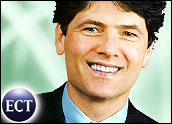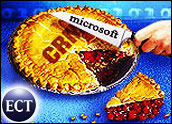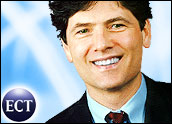
I love it when I can find independent verification for an idea and that’s what happened on Monday when Walker Information released its “2005 Walker Loyalty Report for Software and Hardware.” In case you are not familiar with Walker, this Indianapolis-based company has been studying customer loyalty since the 1930s; somebody ought to put them in the Wikipedia under that topic.
To be totally up front with you, I was an unpaid consultant to the project — along with several other analysts — providing input for the survey instrument, as well as analysis when the data came in. And though I am not on board with all of the findings — I’m just a cranky analyst — I do think there are more than a few nuggets of information to be gleaned from the report.
Loyalty and ROC
For example, you might have noticed that I have been banging my drum a bit lately about Peppers and Rogers new book, Return on Customer because I happen to believe that the path ahead for CRM runs through ideas like organic growth and optimizing relationships leading to multiple sales with each customer. And while Return on Customer talks about a financial analysis metric, Walker’s research provides some good information on generating the loyalty that underpins the metric. From this we can get a sense of the systems and processes we need to push the ball ahead.
Walker has been able to put some numbers on what had, until recently, been a fairly squishy concept. That loyal customers spend more money over time has been common knowledge. But how much emphasis should a company put on loyalty? Does it have quantifiable bottom line importance? Based on this report, I’d say the answers are “A lot” and “Yes.” This survey, which included more than 18,000 brand evaluations by nearly 5,500 respondents, revealed that companies that led their markets in customer loyalty generated average operating margins of 13 percent while loyalty laggards had margins of only 2 percent.
So if loyalty is important, and it is, how do you get it? According to Walker, strong brands and customer-friendly processes are what drive higher levels of customer loyalty. Walker’s process data hits home with CRM on multiple levels. It’s CRM’s job to drive customer processes, so to a great degree customer loyalty becomes a CRM issue pretty quickly. In our era of organic growth, success will be measured less by the number of transactions and more by the value of each one.
You can do many things to build a brand, but when it comes to your business processes an increasing amount of focus is on automation. Loyalty comes down to information systems, CRM especially, because with information you can serve customers better and hopefully in a friendlier manner. That doesn’t necessarily mean injecting a lot of expensive labor into the equation, but it does mean systems that respect people’s time and deliver a product or service when and where it is required.
Limited Comparisons
Of course, it is important to acknowledge the limitations of such a report. Loyalty is an important measure, but it can’t make up for product differences, so some comparisons — if taken too far — will have an apples and oranges character. Here’s what I mean: Microsoft scored well for customer loyalty in the CRM category, but it is hard to make the leap that because Microsoft scored well in loyalty, that the Microsoft CRM product is better than SAP or Siebel. Those three products are very different — two have a heritage of serving large enterprises while Microsoft CRM is focused on smaller organizations. I don’t think there was enough data to compare the loyalty of SAP and Siebel for example, and that’s too bad because it would have been interesting to analyze.
But the report is not exclusively focused on CRM. Other software areas explored include desktop, enterprise, and infrastructure software. And on the hardware side there were categories for mass storage, networked storage, networking equipment and servers & workstations. Overall, software customers are more loyal than hardware customers perhaps because hardware has been so commoditized it is easier to switch and so it is resistant to loyalty.
Also Europeans overall seem to be a less loyal bunch than Americans. More Europeans are categorized as “trapped” or “high risk.” Overall, 53 percent of U.S. respondents categorized as truly loyal while only 41 percent of Europeans fit that category. Regardless, loyalty leadership seems to transcend national boundaries and we find many of the same companies leading the pack on both sides of the Atlantic.
There is a lot more data in the report and I recommend you contact Walker if you want to take a deep dive to better understand the market’s feelings about an area of personal interest. My overall impression is that the results are about what you might expect for a lot of technology that is still rather new — the vast bulk of it was not around when I was in college, and I am not that old. We always want things to be better and we’re willing to continue searching, but at some level we know that high-tech is an evolving field and to one degree or another that’s what makes it so interesting for most of us.
Denis Pombriant is a well known thought leader in CRM and the founder and managing principal of the Beagle Research Group, a CRM market research firm and consultancy. Pombriant’s latest report, CRM WizKids: Taking CRM to the Next Level, identifies emerging CRM leaders and their innovative technologies. In 2003, CRM Magazine named Pombriant one of the most influential executives in the CRM industry. Pombriant is currently working on a book to be published next year. He can be reached at [email protected]
























































